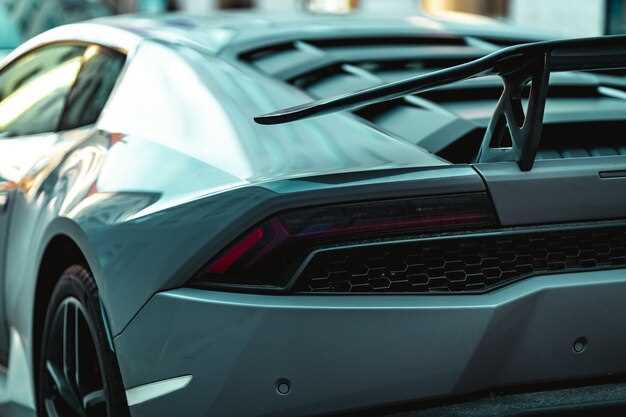Incorporating lightweight materials is a key strategy for enhancing supercar performance. Manufacturers increasingly turn to carbon fiber, aluminum alloys, and composite materials to reduce weight while maintaining structural integrity. This shift not only boosts speed and agility but also improves fuel efficiency and handling.
Carbon fiber, for instance, provides a remarkable strength-to-weight ratio. Supercars made with carbon fiber can achieve significant reductions in weight without sacrificing safety or performance. As a result, these vehicles benefit from quicker acceleration and improved braking distances.
Aluminum alloys offer another valuable option, providing a good balance of lightweight construction and durability. By replacing traditional steel components with aluminum, manufacturers can shave off precious pounds, contributing to better power-to-weight ratios. This change enhances overall handling dynamics, allowing for sharper cornering and a more engaging driving experience.
Choosing the right materials influences the aerodynamics of supercars as well. With a lighter body, designers can optimize shapes for improved airflow, reducing drag and increasing top speeds. The combination of lightweight materials and aerodynamic excellence sets the stage for competitive racing and exhilarating everyday driving.
Understanding Lightweight Materials Used in Supercars
Carbon fiber stands at the forefront of lightweight materials in supercar design. Its impressive strength-to-weight ratio dramatically enhances performance, enabling manufacturers to produce stronger yet lighter components. This material not only reduces overall mass but also improves handling and acceleration.
Aluminum alloys are another popular choice, offering a balance between weight and structural integrity. Supercars leverage specific aluminum grades, such as 6061 and 7075, to optimize strength while minimizing weight. These materials can be easily shaped and welded, allowing for complex designs that enhance aerodynamics.
Magnesium is lighter than aluminum and possesses excellent vibration-dampening properties. It finds application in various supercar parts, including wheels and engine components, contributing to improved handling dynamics. Manufacturers must account for its flammability during production, which typically requires specialized techniques.
Plastics reinforced with composites, such as glass fiber, also play a significant role. While not as strong as carbon fiber, they effectively reduce weight in non-structural applications. Their versatility allows for creative designs without compromising performance. Look for components made from reinforced plastics in body panels and interior trim.
| Material | Properties | Typical Applications |
|---|---|---|
| Carbon Fiber | High strength-to-weight ratio | Chassis, body panels |
| Aluminum Alloys | Good strength and weldability | Frames, suspension components |
| Magnesium | Lightweight and vibration-damping | Wheels, engine components |
| Reinforced Plastics | Lightweight and moldable | Body panels, interior trim |
Advanced manufacturing techniques contribute significantly to the integration of these materials. Methods such as 3D printing and autoclave curing allow for precise control over material properties, facilitating innovation in supercar design. These advancements will continue to shape the future of lightweight materials in automotive engineering.
How Weight Reduction Affects Acceleration and Speed
Reducing weight directly enhances a supercar’s acceleration and speed. A lighter vehicle requires less force to achieve higher speeds, which translates into quicker acceleration times.
Here are the advantages of weight reduction:
- Improved Power-to-Weight Ratio: A lower weight increases the effectiveness of the engine’s power output. For example, a supercar weighing 3,000 pounds with 600 horsepower achieves a power-to-weight ratio of 5:1, compared to a 3,500-pound car with the same horsepower which results in a 5.83:1 ratio.
- Enhanced Stability: Lighter vehicles often exhibit better handling dynamics, allowing for more responsive steering and improved cornering capabilities. This results in a smoother transition throughout acceleration phases.
- Quicker Lap Times: On the racetrack, a reduction of even 100 pounds can yield significant time savings. Tests show that every 100 pounds removed can cut lap times by about 0.2 to 0.5 seconds, depending on the track configuration.
To achieve weight reduction, consider these materials:
- Carbon Fiber: This lightweight composite material offers substantial strength with minimal weight, perfect for body panels and structural components.
- Aluminum: Known for its low density, aluminum is often used in engines and suspension systems to decrease the overall mass.
- Magnesium: Utilized in wheels and engine components, magnesium is one of the lightest metals available, providing excellent performance benefits.
Implementing these materials not only improves speed but also contributes to better fuel efficiency. A lighter vehicle can travel farther on the same amount of fuel, which is a considerable advantage in performance driving.
In summary, weight reduction plays a significant role in enhancing both acceleration and speed, making it a critical focus in supercar design. Prioritize the use of advanced materials to see substantial improvements in your vehicle’s performance.
The Role of Aerodynamics in Combination with Lightweighting
Aerodynamics significantly enhances the performance of lightweight supercars by optimizing airflow around the vehicle. Implementing aerodynamic designs reduces drag and increases downforce, enabling higher speeds and improved stability. Supercars benefit from streamlined shapes that minimize turbulence and streamline airflow, allowing them to achieve maximum efficiency.
Incorporating lightweight materials, like carbon fiber and aluminum, alongside aerodynamic improvements amplifies performance. Every kilogram reduced in weight can lead to considerable enhancements in acceleration and braking. Combining lightweighting with a well-designed aerodynamic profile boosts the power-to-weight ratio, essential for supercar agility.
Utilizing active aerodynamics complements lightweight structures. Adjustable wings and diffusers can change their shape or angle based on speed, enhancing downforce during high-speed driving and reducing drag when speed decreases. This dynamic interaction optimizes performance by adapting to driving conditions effectively.
Wind tunnel testing plays a critical role in refining aerodynamic features. Supercar manufacturers often create multiple prototypes to test varying shapes and materials, ensuring that the final design achieves the best balance between weight and aerodynamic efficiency. Computational Fluid Dynamics (CFD) further enhances this process, allowing designers to visualize airflow without extensive physical testing.
Investing in aerodynamics alongside lightweight construction leads to significant gains in track performance. Enhanced cornering speeds and stability at high velocities translate into better lap times and a more exhilarating driving experience. This symbiotic relationship between lightweighting and aerodynamics maximizes supercar potential on both road and track.
Comparative Analysis: Lightweight Materials vs. Traditional Components
Choosing lightweight materials like carbon fiber or aluminum significantly enhances supercar performance compared to traditional steel or heavier composites. For instance, carbon fiber offers a strength-to-weight ratio approximately five times greater than steel. This advantage translates directly into superior acceleration, braking, and handling capabilities.
Traditional components, while durable, contribute to increased weight, which negatively impacts speed and fuel efficiency. A supercar weighing just 100 kg less can improve lap times by seconds, a critical factor in competitive racing scenarios. Additionally, lighter materials allow for more agile design and innovations in aerodynamics.
Cost is often a consideration; lightweight materials can be more expensive. However, the long-term benefits in performance and efficiency frequently justify the initial investment. Assembling a supercar with advanced materials may require specialized manufacturing techniques, but the resulting structure offers enhanced safety through improved crumple zones and impact resistance.
Employing lightweight materials doesn’t just enhance performance; it reshapes the very nature of supercar design. Engineers can allocate power more effectively and optimize engine performance, marrying lightweight construction with high-powered engines for maximum impact. The acceleration times and top speeds of models utilizing these materials consistently outperform their heavier counterparts.
The future of supercar development rests on continued innovation in lightweight materials. Ongoing research into composites and alloys is set to refine performance even further, positioning manufacturers who adopt these materials at a competitive advantage. Transitioning to lightweight solutions represents a strategy that pays off both on the track and in the showroom.
The Influence of Lightweight Design on Handling and Stability
Adopting lightweight materials directly enhances a supercar’s handling and stability. By reducing overall weight, designers lower the car’s center of gravity, which improves balance during cornering. This results in quicker response times and better maneuverability.
Using materials like carbon fiber or aluminum allows for a larger weight-to-power ratio. For instance, a supercar weighing 2000 pounds can gain a performance edge over a heavier competitor by utilizing a lightweight chassis. The result is a more agile vehicle that can change direction with less effort and improved precision.
Reducing unsprung weight–components not supported by the vehicle’s suspension, such as wheels and brakes–also contributes to better stability. Less weight here allows for quicker adjustments and improved grip, especially on uneven surfaces. This leads to enhanced traction during acceleration and braking, giving drivers more control in various conditions.
A well-optimized weight distribution further stabilizes the vehicle. When lighter components are strategically placed, the dynamic balance during high-speed maneuvers is greatly enhanced. Drivers experience more predictable behavior in turns, with reduced likelihood of understeering or oversteering.
Fine-tuning suspension systems in conjunction with lightweight design can amplify these benefits. A lighter car can utilize stiffer springs and dampers, leading to improved feedback and road feel. This combination ensures that a driver remains connected to the road surface, enhancing confidence while cornering at high speeds.
In summary, lightweight design plays a pivotal role in enhancing handling and stability, allowing supercars to perform at their best while providing an exhilarating driving experience.
Future Trends in Lightweight Materials for Supercar Innovation
Focus on advanced composites like carbon fiber reinforced polymers (CFRP) as key players in lightweight construction. Innovations in resin systems enhance durability while reducing weight, allowing for finer designs that improve aerodynamics and performance.
Explore the potential of graphene and its derivatives in manufacturing processes. This material offers high tensile strength and minimal weight, which can lead to substantial gains in supercar efficiency and speed. Ongoing research into scalable graphene production aims to make it viable for broader application in automotive industries.
Investigate bio-based materials as sustainable alternatives. They not only lower environmental impact but can also match traditional materials in strength and weight. Companies are experimenting with flax and hemp composites, which demonstrate impressive properties in structural applications.
Keep an eye on metallic structures utilizing aluminum-lithium alloys. These materials provide a robust and lightweight solution, perfect for structural components demanding high strength. Future formulations may enhance fatigue resistance and machinability, crucial for high-performance vehicles.
Leverage 3D printing technology in prototyping and production. This approach can create complex geometries that traditional methods struggle to achieve, leading to reductions in material waste and weight without sacrificing performance. Integrating 3D printing with lightweight materials can streamline manufacturing processes significantly.
Stay updated on the integration of artificial intelligence in material selection and design optimization. AI-driven simulations can predict performance outcomes based on various material combinations, enabling faster, smarter decision-making for supercar manufacturers.
Collaborate with material scientists to foster cross-disciplinary innovation. Engaging universities and research institutions will catalyze experimental approaches to lightweight materials, accelerating industry adoption and opening new design possibilities.







